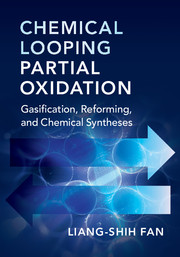Book contents
- Frontmatter
- Dedication
- Epigraph
- Contents
- In Cooperation with Professor Fan's Research Group Members
- Preface
- Nomenclature
- Abbreviations
- 1 Overview
- 2 Metal Oxide Oxygen Carriers
- 3 Oxidative Coupling of Methane
- 4 Syngas Generation
- 5 Catalytic Metal Oxides and Applications
- 6 Process Simulations and Techno-Economic Analyses
- Index
- Color plate section
1 - Overview
Published online by Cambridge University Press: 07 November 2017
- Frontmatter
- Dedication
- Epigraph
- Contents
- In Cooperation with Professor Fan's Research Group Members
- Preface
- Nomenclature
- Abbreviations
- 1 Overview
- 2 Metal Oxide Oxygen Carriers
- 3 Oxidative Coupling of Methane
- 4 Syngas Generation
- 5 Catalytic Metal Oxides and Applications
- 6 Process Simulations and Techno-Economic Analyses
- Index
- Color plate section
Summary
Introduction
The term “chemical looping” was first used by Ishida et al. (1987) to describe a high exergy efficiency combustion process that engages redox reactions employing metal oxides as a reaction intermediate. In an earlier book of Fan, the term “chemical looping” was used in a broad sense to describe the nature of a reaction scheme in which a given reaction is decomposed into multiple sub-reactions using chemical intermediates that are reacted and regenerated. Further, the sub-reactions are ideally configured in such a manner that the exergy loss of the process as a result of this reaction scheme can be minimized. The term in this broad sense, which has been of interest to industrial practice, can be dated to the late nineteenth century, and is used again in this book. The chemical intermediates considered in the chemical looping reactions are mainly metal oxides. The concept of chemical looping is rooted in the second law of thermodynamics as applied to the reduction of process irreversibility and hence the enhanced exergy efficiency of the process. The application of this exergy concept for combustion systems was reported earlier by Knoche and Richter (1968, 1983). In the work of Ishida et al. (1987), they employed metal oxides such as NiO, CuO, Mn2O3, and Fe2O3 as chemical intermediates for combustion reaction applications. The unique feature of using a metal oxide in a chemical looping combustion scheme is that CO2 becomes an easily separable combustion product and thus, the parasitic energy requirement in the CO2 separation is low in this combustion system. Such a CO2 separation feature has been deemed to be important in recent years, particularly in light of global concerns over the increasing CO2 concentration in the atmosphere.
Aside from electricity generation from chemical looping combustion, chemicals can also be generated from chemical looping routes that have considerable process advantages. Chemicals such as propylene, butadiene, benzene, and xylene are currently produced mainly from petroleum through catalytic and/or thermal cracking processes of crude oil to naphtha, butane, and propane. When the feedstock is coal or natural gas, the production processes are different. For coal, chemicals are produced via two routes. One route is through coal gasification to generate syngas, then synthesized to chemicals; the other route is through coal pyrolysis to generate volatiles, then refined to chemicals.
- Type
- Chapter
- Information
- Chemical Looping Partial OxidationGasification, Reforming, and Chemical Syntheses, pp. 1 - 54Publisher: Cambridge University PressPrint publication year: 2017

